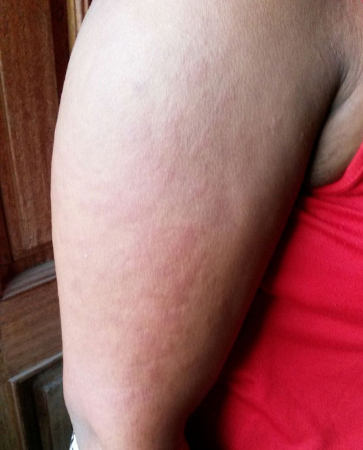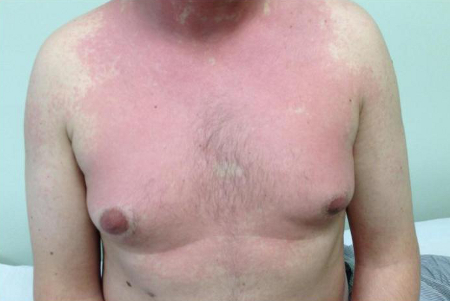History and exam
Key diagnostic factors
common
fever ≥39.0°C (≥102.2°F)
Fever is the most common presenting feature of AOSD and is reported in 91% to 100% of patients with the condition.[5][7][25][28][29][30][31]
Typically there is a high-spiking fever, occurring daily or occasionally twice daily over a period of at least 1 week and resolving each time within a few hours.[5][48]
arthritis
Arthritis typically begins as mild and localised, but it can become increasingly severe and polyarticular over the course of the disease.[5] It is seen in 51% to 65% of patients with AOSD.[5][7][25][28][29][30][31]
Joints that are commonly affected include the proximal interphalangeal joints, wrists, elbows, knees, and ankles. The distal interphalangeal joints and shoulder joints are typically spared.[23][25][32][33][34][35]
salmon-coloured maculopapular skin rash
The rash associated with AOSD is classically salmon-pink, non-pruritic, and maculopapular, and occurs during fever. Reported in 62% to 80% of patients with AOSD.[5][7][25][28][29][30][31]
There can be other skin manifestations of the disease, such as urticarial dermographism.
[Figure caption and citation for the preceding image starts]: Salmon-pink rash typical of AOSD on right arm of a 28-year-old woman of Nigerian heritageAkintayo RO et al. BMJ Case Reports 2015; 2015: bcr2015210789; used with permission [Citation ends]. [Figure caption and citation for the preceding image starts]: Salmon-pink rash on the chest and neck of a white man with AOSDFrom the collection of Dr Sinisa Savic; used with permission [Citation ends].
[Figure caption and citation for the preceding image starts]: Salmon-pink rash on the chest and neck of a white man with AOSDFrom the collection of Dr Sinisa Savic; used with permission [Citation ends].
Other diagnostic factors
common
dermographic urticaria
Urticaria and dermographism is seen in 31% to 59% patients.[5] Urticaria are pruritic hives that appear and resolve over minutes to hours, leaving normal skin behind. In the case of dermographism, the hives typically arise from scratching or mild trauma of the skin.
Neutrophilic urticarial dermatosis, consisting of urticarial lesions lasting 24-48 hours with dense neutrophilic infiltrates on biopsy, may also occur.[5]
sore throat
myalgia
Reported in around 26% to 53% of patients with AOSD, typically occurring during fever.[5]
lymphadenopathy
pleuritis
There is a variable incidence of pleuritis reported in different studies, but it can occur in up to 53% of patients with AOSD.[5]
One retrospective study of 62 patients with AOSD showed that those ≥65 years old had a significantly higher incidence of pleuritis compared with younger patients (46% vs. 17%).[37]
uncommon
splenomegaly
hepatomegaly
pericarditis
myocarditis
Central chest pain, dyspnoea, orthopnoea.
Occurs in up to 7% of patients with AOSD.[45]
signs of macrophage activation syndrome (MAS)
MAS is a complication of AOSD that may be the initial presenting feature. Reports of its frequency vary widely, ranging from 1.7% to 23% of AOSD patients.[1][4][5]
It classically presents with fever with hepatosplenomegaly and lymphadenopathy.
Easy bruising or bleeding (e.g., mucosal) is another feature.
Around 35% of patients with MAS (from any cause) develop CNS symptoms, including seizures and alterations in mental state. It can progress to multi-organ failure.[62][63]
Risk factors
weak
female sex
young adult age
Most cases of AOSD occur in young adults, with a bimodal pattern showing two peaks of onset at ages 16-25 years and 36-46 years.[1][5] However, there is now increasing evidence of a further peak between the ages of 60 and 65 years.[7][8][9][10][16] Case series suggest that around 7% to 10% of cases are first diagnosed in patients older than 60 years although delayed diagnosis may be a contributory factor.[5]
Use of this content is subject to our disclaimer